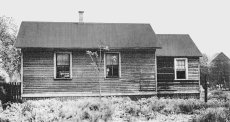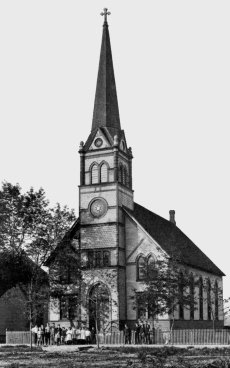|
1870
Zion
differs from the majority of Lutheran congregations in that it was not
founded by missionary pioneers of Lutheran heritage.* Prior to 1870,
Zion, which owned a church building in Washington Heights,
Illinois, at what is now known as the corner of West 99th Street and
Winston Avenue, holds membership with the Evangelical Church. In 1870,
internal dissension in that denomination results in the desire on the
part of Zion Congregation to become Lutheran in name as well as in
character. Moreover, its most recent pastor has been exposed as a
swindler and defrocked. Zion Congregation refers its problem
to the Rev. Augustus Reinke, pastor of the first and, at the time, only
Lutheran congregation in nearby Blue Island. Soon afterward, the 18
families of Zion adopt a Lutheran
constitution and join the Missouri Synod. The church is named "The First
German Evangelical Lutheran Zions Church of Washington Heights, Cook
County, Illinois, U.A.C." (Unaltered Augsburg Confession).
Charter members are
William Beyer, Julius Boelter, Julius Bohm, J. Borndell, C. Degenhardt,
Henry Fink, John Haas, John Hansen, Michael Hemmrich, Peter Jacob,
Albert Jansen, Jacob Landeck, David Mell, Joachim Zander and William
Zander.
1878
Two men, Michael Hemmrich and Peter Jacob, determine how
many children would enroll if a school were to be founded.
1879
A school building is built, and the school opens with an enrollment of 30
children. The dues are as follows: 75 cents for one child, 50 cents each
for two, three, four, and five children of the same family. The teacher
who is hired, Mr. Henry Mertens, receives a salary of $350 a year.
1881
Zion becomes
involved in the controversy on election and predestination within the
Evangelical Lutheran Synodical Conference of North America. Pastor
H.P. Duborg and a majority of the members follow the doctrine of the Ohio
Synod and establish a church a few blocks from Zion. The "remnant" of
Zion is served by Rev. Carl F. Eissfeldt, pastor of Immanuel in South
Chicago, and Rev. Louis Hoelter, pastor of First Immanuel in Chicago.
When the congregation in Blue Island also joins the Ohio Synod, a few of
its members who want to remain with the Missouri Synod come to Zion in
Washington Heights. The fact that Zion flourishes is due, under God,
mainly to layman Andreas
Christian Landeck, who worked tirelessly day and night during the controversy to hold the congregation together
– visiting,
admonishing, and distributing tracts.
1890
The
Village of Washington Heights is annexed to Chicago.
|

Zion's first home, from 1870
through 1891, is
this small cabin with a hitching post and a few wooden planks to serve
as walkways. Plumbing, heating, and electricity are not added for
another generation.
(CLICK ON PHOTO TO ENLARGE)

This frame church building
serves Zion from 1891 through 1937, when it is razed to make way for the
present stone church building.
(CLICK ON PHOTO TO ENLARGE)
1891
Communicant membership is 183. The old church is converted to a school.
A new frame church building is built with a seating capacity of 200. The
evening of the dedication, the first English sermon is preached by Rev.
A. Sloan Bartholomew, pastor of Christ English Congregation in Chicago
(the first congregation in northern Illinois to join the English Synod,
which, in 1911, joins the "German" Missouri Synod as a non-territorial district).
1894
A bell
is purchased for the new church. It had been cast for another church and
was to be used as part of a three-bell ensemble, but was slightly off
pitch. Zion obtained the bell, which was priced at $1,750, for $300. The
old bell is presented to the Missouri Synod's Concordia College in St.
Paul, Minnesota.
1906
Rev.
Edward Tappenbeck is called to serve at Zion, where he remains for many
years.
1914
Mr. Alwin
Roschke, a graduate of Concordia Teachers College in River Forest,
Illinois, is installed to teach in Zion's one-room schoolhouse.
1916
A basement assembly hall is added underneath the church. The frame
church building is raised to allow this. Electric lighting is installed
in the church.
1919
The church steeple is struck by lightning.
|
1921
The
school is divided into two classrooms. Mr. Roschke is the principal and
teaches the upper grades.
1923
The present brick school building is erected.
1928
Two bowling alleys are installed in the school building.
1930
Pastor Tappenbeck's 24-year ministry at Zion ends with his death. Rev. Carl Abel is installed.
1937
The frame church and parsonage are torn down and the present Lehigh stone church
building is erected at a cost of $60,000.
1948
A third classroom is added to the school.
1950
The German service is discontinued.
Zion
becomes a charter member in the Chicagoland Lutheran High School
Association. Members of Zion contribute over $100,000 for capital
expenditures plus $3,000 a year for operation and maintenance of Luther
High School South at 87th Street and Kedzie Avenue in Chicago.
1953
An addition is
built at the back of the second floor of the school building to create a fourth classroom.
1955
Mr.
Alwin Roschke, school principal, retires after 40 years at Zion.
1960
Communicant membership hits a peak of 978.
1962
Pastor Carl Abel is elected president of the Northern Illinois
District of the Missouri Synod.
1963
Pastor Abel, who has served the congregation for 33 years, dies suddenly,
and Vicar Robert Petersen is granted permission by the Seminary to remain
at Zion for an extra year.
1964
A new pipe organ is installed in the church.
1965
A kindergarten class and library are added to the school.
1968
A radio mission is established, and a full hour of services is broadcast
every Sunday. The need for an assistant pastor is felt, and a call is
extended to the Seminary for a graduate.
1970
100th anniversary observed.
Communicant membership is 760.
1978
The school is closed and the school building eventually sold. It currently
is occupied by a Christian elementary school:
Covenant Christian Academy
(773) 881-3235
EMAIL THE ACADEMY
www.ccaofchicago.org
2000
130th anniversary observed.
2005
135th anniversary observed.
 |